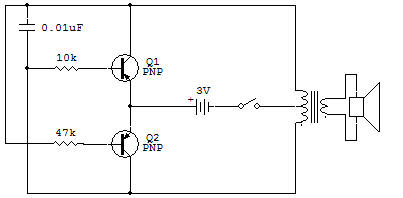

Push/Pull Square Wave Oscillator

This project demonstrates a push/pull, square wave oscillator. The square wave is used for many applications in electronics. Some of these uses include: driving logic circuits, which require fast rising and falling voltage waveforms to trigger the logic circuits operation, converting DC to AC with high efficiency, testing frequency and phase response of circuits, etc.
A square wave is rich in odd harmonic frequencies. That is, a 100 hertz square wave also contains frequencies of 300, 500, 700, 900Hz, etc., all of which are equal to the fundamental frequency of 100 times the odd counting numbers. The strength of the harmonic frequencies decreases as the frequency increases, but for good square waves measurable harmonics exist up to dozens of times higher than the fundamental.
The 0.01 uF Capacitor is added to insure that spikes of high frequency content are minimized. Without this Capacitor the output is not a clean square wave, but is mainly spikes.
This circuit is very reliable for low DC supply voltages. For this reason, it is very popular in DC to AC converters and DC to DC inverters, where the supply voltage is anything from about 0.5 to 12 volts. You may want to experiment with lower voltages for this circuit.
Do not use higher voltages on this particular circuit or the Q1 (which is a low-power RF Transistor) may be ruined.
Another characteristic of this oscillator is that it makes maximum use of the Transformer power handling capability. That is, maximum output power is obtained for the particular size Transformer used.
